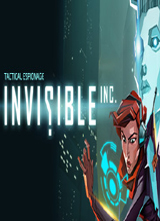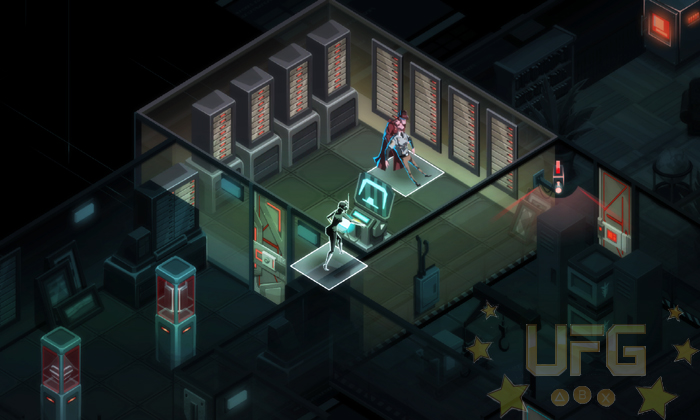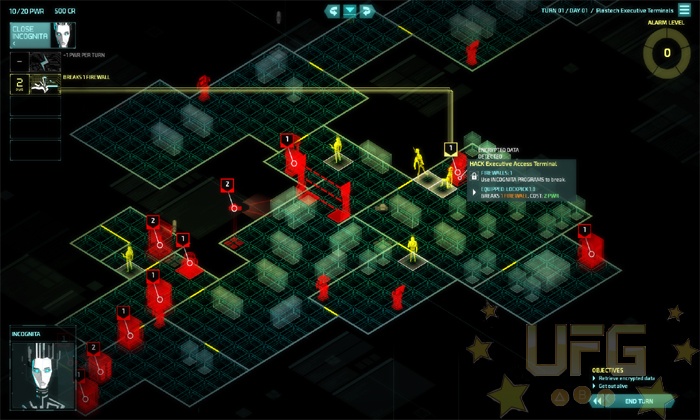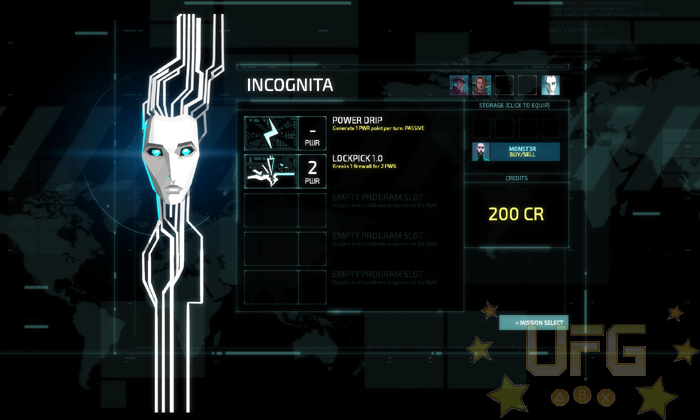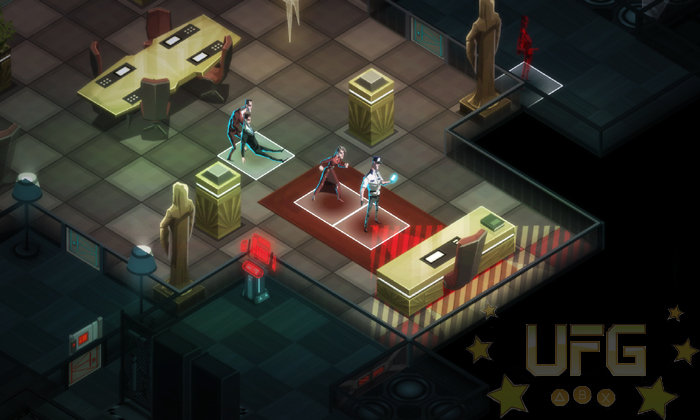Invisible, Inc.
One of the things that makes Klei such a good indie developer is the fact that they aren’t afraid to tackle different types of game. N+, Shank, Mark of the Ninja, Don’t Starve – their titles span a multitude of genres. It’s gotten to the point where although gamers aren’t surprised, they are still excited by Klei’s announcements. At least, that’s how I felt after hearing about Invisible, Inc., a turn based stealth game that was headed to Steam Early Access.
Invisible, Inc.’s narrative takes place in the near future, where large corporations rule the world. Each one more devious than the next, they often try to sabotage each other by hiring private intelligence agencies, namely Invisible, Inc., to infiltrate their rival’s headquarters and steal valuable information. Apparently these corporate entities grew tired of Invisible’s meddling and decided to join up to hunt them down. At the start of the game we see the fruits of their union; Invisible, Inc. has their doors kicked in by a private militia, resulting in most of their agents being killed or captured. Luckily, the head of Invisible was able to escape with the help of two agents who were out in the field at the time. Before she left, she grabbed Incognita, a powerful AI system needed to help them get back on their feet. Unfortunately, Incognita needs to be housed in a supercomputer and can only function outside of one for 72 hours. In order for Invisible to survive, they’ll need to find a new supercomputer as well as who or what was able to convince the world’s most powerful corporations to target them in the first place.
Each session starts with two agents of your choosing and the goal of gathering information, assembling supplies, and rescuing captured agents within a three day period. During this time Incognita will give you choices of corporate buildings to infiltrate, each with their own threat level and possible rewards. For instance, a server farm might yield some information on other corporations that were involved in the attack on Invisible. But because the farm is basically a library of computer terminals, regular security guards and cameras will be the only obstacles (low level threat). If you succeed in mining important information, Incognita will give you more choices for your next mission. The idea is to help her figure out who the main culprit is while equipping your agents so they’re strong enough to confront the adversaries or at the very least, utilize their supercomputer.
Rogue-like elements and procedurally generated environments are all the rage nowadays. This holds true with Invisible, Inc., though this isn’t a bad thing. After selecting a target to hit, your available agents will be beamed into the building. From here, you’ll take turns moving the agents around the environment in search of their goal. This is done via action points, where each character has a set limit of points to move, open doors, knock out guards and so on. Once you’re done moving all of your agents (or after deciding to end your turn early), the enemy will take their turn moving around. Because the interiors are randomly put together and the fog of war – a mechanic that conceals enemy presence and objectives – is present in any area you haven’t visited, you’ll never know how many guards are patrolling the halls or where they are on the onset of your mission.
This alone creates tension as you move from one hiding place to the next, trying to stay out of a guard’s view. Intensifying the imminent threat is a security timer will start counting up once your agents are beamed in. The corporations all have their own AI systems that notice your presence. And while they don’t outright sound the alarms, they’ll continue to raise the threat level from one to six. At level two, more cameras will be activated. At level three, another guard will start patrolling. At level four, hacked equipment may revert back to normal and an elite guard may spawn. At levels five and six…well, let’s just say that it would be better if your agents weren’t there.
One wrong move could get one of your agents killed. And like other Rogue-inspired games, death is permanent. That said, there are ways to get your agents in and out of these dangerous places safely. Action points can be used to peak through a door to see if there are any guards and/or predict their patrol pattern once seen. An agent can also use action points to sneak up on a guard and subdue them, leaving them unconscious for a number of turns. Every agent has special items or augmentations (cybernetic implants) to help them as well. One of my favorites is agent Decker’s ability to turn invisible for one turn, easily evading enemies. If Incognita has enough power, gained by having your agents hack terminals, she can crack security codes and take over enemy equipment. All of these items and abilities have cool down times, so you’ll have to decide when it is best to use them. A given situation could turn ugly if an agent is caught out in the open without access to his or her gadgets.
If you are seen, it doesn’t mean instant doom as the game will allow agents to move one space in any direction. As long as they end up behind cover during said move, they won’t be killed. Another agent can also intervene, knocking out the guard to let the other escape. Once they awake however, the guard will actively hunt the agents from that point forward. Speaking of which, the guards featured here are smart. Once they notice a disturbance, they’ll never “cool down” and return to normal. Some of the higher ranking guards will toss electronic sensors into a room before entering in hopes of scanning an agent in hiding. It can be tricky evading them while securing precious cargo.
To highlight how all of these elements come together, I’ll give an account of one of my missions. I had just rescued an agent from a previous outing and so together I had four operatives going into the next facility. Because we were stealing something major, the grounds were crawling with guards (high level threat). By carefully weaving through this labyrinth like environment and hacking the appropriate terminals, I was able to find the vault housing the goods. To my dismay, the vault door was behind a lethal laser grid. So, I sent three agents out to take down the power source, leaving one at the door. It wasn’t long before I grew impatient, spinning the overhead view around as my agents searched every nook and cranny. My haste caused one of them to get caught in the open by a guard wearing armor. I had no choice. Because his armor prevented me from stunning him, I had to use an accompanying agent’s gun to put him down. His death raised the threat level two fold, spawning in an elite guard and a walking turret. I was able to find the power source (a random generator), shutting it down with Incognita just as the enemy was closing in.
The agent at the vault, using a key card I’d stolen a few mission back, was able to make it inside. Doing so tripped an alarm, again raising the threat level. I’m sweating now. The guards split up. A few headed to the vault while the others made a bee-line for my agents near the generator. During my turn, I was able to have the agent at the vault grab the goods and then set up an ambush near the door; that way she’d attack the first person that walked through. I also started moving the other agents towards the exit as well as hack the walking turret. After the enemy’s turn, I used the turret to take down another guard before losing control of it, had my agent at the vault knock out a guard, and hacked a camera to help plan an alternate escape route. While racing to the exit, one agent was shot.
Now, I could choose to turn back and help him using medical items or have the other two hightail it out of there. I chose the latter as my main concern now was getting my agent at the vault out with the spoils. If I failed the mission, that would mean wasted time and resources. By picking up the injured guard and placing him in plain view, I was able to get my enemy looking in a desired location. At that point I was able to slip by a few baddies before being spotted by camera drone (how did I miss that) and of course, the exit teleporter was on a cool down so I’d to wait for it to power back up before escaping. At threat level six, things were really heating up.
Ultimately, I was able to escape after losing the drone. The mission wasn’t a complete success since I was now down an agent. That scenario could have gone down differently depending on my available skills, items, level layout, etc. For the most part though, the results of my actions are permanent. The game can be quite challenging but it never reaches the point of frustration; even if the campaign ends prematurely, you’ll gain experience points that’ll unlock new agents and Incognita abilities, allowing for more options during a given mission. Not only that but some difficulty settings will allow you to retry failed missions with a new layout as well as rewind a bad turn or two. The only time I felt things go off the rails was when a map was generated without a power source, used to power down lasers blocking a door. It was probably a glitch (it only happened once) but it forced me to escape before completing the objective. Other than that, my time with Invisible, Inc. was rather entertaining to the say the least.
There are different modes to tackle, including the Endless and Time Attack modes. There’s also a custom option that allows you to set your own parameters. This along with the procedurally generated content lends to a decent replay value. Klei’s awesome art style shines here, the voice work is decent, and the music/sound effects work well with the game’s theme. Again, what makes Klei such a good indie developer is the fact that they aren’t afraid to tackle different types of game. What makes them great is that they’ve found a way to excel in each genre!
Gameplay:
9
Invisible, Inc. is as engaging as it is difficult. It’s really hard to put down…
Graphics:
10
Klei’s stylized graphics are one part cyberpunk, one part film noir mashed together with a vibrant color palette.
Sound:
8
The small amount of voice work is decent and the music isn’t bad.
Replay Value:
9
The procedurally generated content, range in difficulty, and unlockables warrant multiple playthroughs.
Final Score:
9
